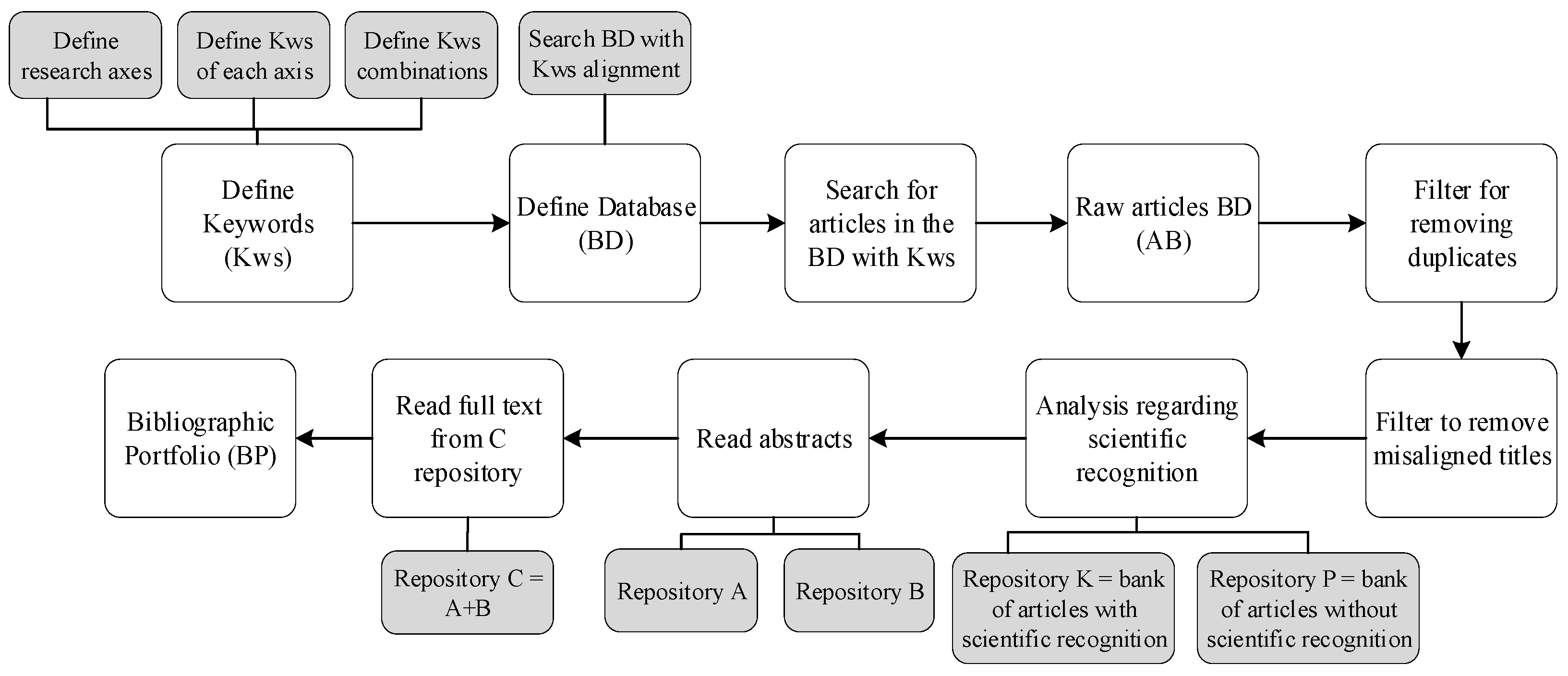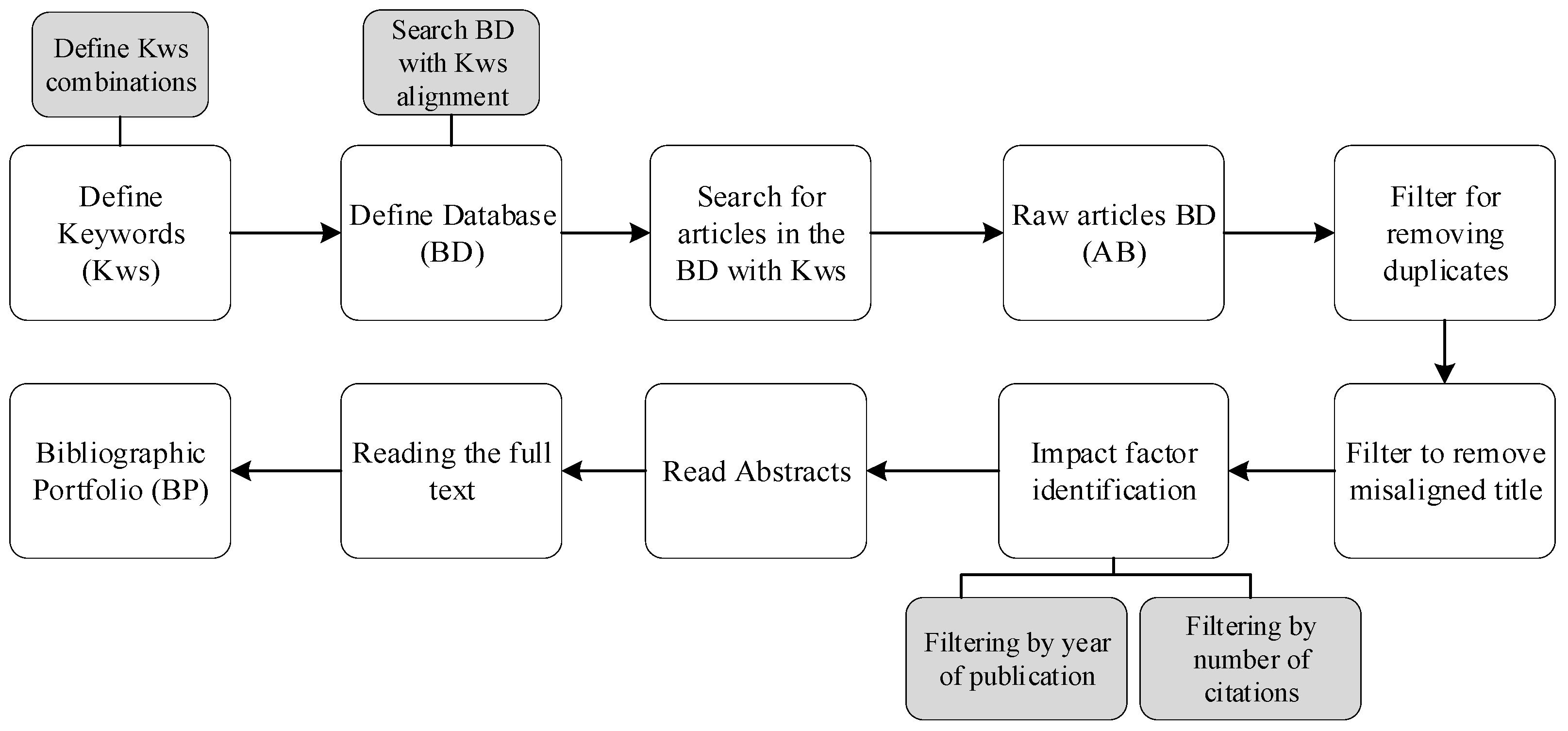Non-Invasive Techniques for Monitoring and Fault Detection in Internal Combustion Engines: A Systematic Review
Abstract
1. Introduction
2. Systematic Review
3. Results and Discussions
4. Conclusions
Author Contributions
Funding
Data Availability Statement
Acknowledgments
Conflicts of Interest
References
- IEA; IRENA; UNSD; World Bank; WHO. Tracking SDG 7: The Energy Progress Report; WHO: Washington, DC, USA, 2024; p. 179.
- Sachs, J.; Kroll, C.; Lafortune, G.; Fuller, G.; Woelm, F. Sustainable Development Report 2022, 1st ed.; Cambridge University Press: Cambridge, UK, 2022; ISBN 978-1-00-921005-8. [Google Scholar]
- CODS. Índice ODS 2022 para América Latina y el Caribe; Centro de los Objetivos de Desarrollo Sostenible para América Latina y el Caribe: Bogotá, Colombia, 2023; Volume 10, p. 100. [Google Scholar]
- Ovrum, E.; Longva, T.; Leisner, M.; Bachmann, E.M.; Gundersen, O.S.; Helgesen, H.; Endresen, O. Energy Transition Outlook 2024—Maritime Forecast to 2050; DNV: Oslo, Norway, 2023; p. 73. [Google Scholar]
- IMO. 2023 IMO Strategy on Reduction of Ghg Emissions from Ships; MEPC 80/WP.12; International Maritime Organization: Oslo, Norway, 2023; p. 18. [Google Scholar]
- UNCTAD. Review of Maritime Transport 2024: Navigating Maritime Chokepoints, 1st ed.; Review of Maritime Transport Series; United Nations Research Institute for Social Development: Bloomfield, NJ, USA, 2024; ISBN 978-92-1-106592-3. [Google Scholar]
- Heywood, J.B. Internal Combustion Engine Fundamentals. In McGraw-Hill Series in Mechanical Engineering; McGraw-Hill: New York, NY, USA, 1988; ISBN 978-0-07-028637-5. [Google Scholar]
- Bosch, R. Manual de Tecnologia Automotiva; Tradução da 25a ed. Alemã; Edgard Blücher: São Paulo, Brazil, 2005; ISBN 978-85-212-0378-0. [Google Scholar]
- Brunetti, F. Motores de Combustão Interna; Editora Edgard Blucher: São Paulo, Brazil, 2022; Volume 1, ISBN 978-85-212-1293-5. [Google Scholar]
- Nahim, H.M.; Younes, R.; Nohra, C.; Ouladsine, M. Complete modeling for systems of a marine diesel engine. J. Marine. Sci. Appl. 2015, 14, 93–104. [Google Scholar] [CrossRef]
- Lim, K.Y.H.; Zheng, P.; Chen, C.-H. A state-of-the-art survey of Digital Twin: Techniques, engineering product lifecycle management and business innovation perspectives. J. Intell. Manuf. 2020, 31, 1313–1337. [Google Scholar] [CrossRef]
- Stoumpos, S.; Theotokatos, G.; Mavrelos, C.; Boulougouris, E. Towards Marine Dual Fuel Engines Digital Twins—Integrated Modelling of Thermodynamic Processes and Control System Functions. J. Mar. Sci. Eng. 2020, 8, 200. [Google Scholar] [CrossRef]
- Tran, V.D.; Sharma, P.; Nguyen, L.H. Digital twins for internal combustion engines: A brief review. J. Emerg. Sci. Eng. 2023, 1, 29–35. [Google Scholar] [CrossRef]
- Xu, Z.; Ji, F.; Ding, S.; Zhao, Y.; Zhou, Y.; Zhang, Q.; Du, F. Digital twin-driven optimization of gas exchange system of 2-stroke heavy fuel aircraft engine. J. Manuf. Syst. 2021, 58, 132–145. [Google Scholar] [CrossRef]
- Cheng, D.-J.; Zhang, J.; Hu, Z.-T.; Xu, S.-H.; Fang, X.-F. A Digital Twin-Driven Approach for On-line Controlling Quality of Marine Diesel Engine Critical Parts. Int. J. Precis. Eng. Manuf. 2020, 21, 1821–1841. [Google Scholar] [CrossRef]
- Minchev, D.; Varbanets, R.; Shumylo, O.; Zalozh, V.; Aleksandrovska, N.; Bratchenko, P.; Truong, T.H. Digital Twin Test-Bench Performance for Marine Diesel Engine Applications. Pol. Marit. Res. 2023, 30, 81–91. [Google Scholar] [CrossRef]
- Neumann, S.; Varbanets, R.; Minchev, D.; Malchevsky, V.; Zalozh, V. Vibrodiagnostics of marine diesel engines in IMES GmbH systems. Ships Offshore Struct. 2023, 18, 1535–1546. [Google Scholar] [CrossRef]
- Dong, F.; Yang, J.; Cai, Y.; Xie, L. Transfer Learning-Based Fault Diagnosis Method for Marine Turbochargers. Actuators 2023, 12, 146. [Google Scholar] [CrossRef]
- Rodríguez, C.G.; Lamas, M.I.; Rodríguez, J.D.D.; Caccia, C.; Politecnico di Milano, Italy. Analysis of The Pre-Injection Configuration in a Marine Engine through Several MCDM Techniques. Brod. Int. J. Nav. Archit. Ocean. Eng. Res. Dev. 2021, 72, 1–17. [Google Scholar] [CrossRef]
- Hountalas, T.D.; Founti, M.; Zannis, T.C. Experimental Investigation to Assess the Performance Characteristics of a Marine Two-Stroke Dual Fuel Engine under Diesel and Natural Gas Mode. Energies 2023, 16, 3551. [Google Scholar] [CrossRef]
- Korczewski, Z. Test Method for Determining the Chemical Emissions of a Marine Diesel Engine Exhaust in Operation. Pol. Marit. Res. 2021, 28, 76–87. [Google Scholar] [CrossRef]
- Bogdanowicz, A.; Kniaziewicz, T. Marine Diesel Engine Exhaust Emissions Measured in Ship’s Dynamic Operating Conditions. Sensors 2020, 20, 6589. [Google Scholar] [CrossRef] [PubMed]
- Varbanets, R.; Shumylo, O.; Marchenko, A.; Minchev, D.; Kyrnats, V.; Zalozh, V.; Aleksandrovska, N.; Brusnyk, R.; Volovyk, K. Concept of Vibroacoustic Diagnostics of the Fuel Injection and Electronic Cylinder Lubrication Systems of Marine Diesel Engines. Pol. Marit. Res. 2022, 29, 88–96. [Google Scholar] [CrossRef]
- Tharanga, K.L.P.; Liu, S.; Zhang, S.; Wang, Y. Diesel Engine Fault Diagnosis with Vibration Signal. J. Appl. Math. Phys. 2020, 8, 2031–2042. [Google Scholar] [CrossRef]
- Varbanets, R.; Fomin, O.; Píštěk, V.; Klymenko, V.; Minchev, D.; Khrulev, A.; Zalozh, V.; Kučera, P. Acoustic Method for Estimation of Marine Low-Speed Engine Turbocharger Parameters. J. Mar. Sci. Eng. 2021, 9, 321. [Google Scholar] [CrossRef]
- Deptuła, A.; Kunderman, D.; Osiński, P.; Radziwanowska, U.; Włostowski, R. Acoustic Diagnostics Applications in the Study of Technical Condition of Combustion Engine. Arch. Acoust. 2016, 41, 345–350. [Google Scholar] [CrossRef]
- Junior, E.M.D.S. Técnica de Diagnóstico de Falhas em Motores à Combustão Interna Utilizando Aprendizagem de Máquina. Ph.D. Thesis, Programa de PósGraduação em Engenharia Mecânica, Universidade Federal do Rio Grande do Norte, Natal, RN, Brazil, 2018. [Google Scholar]
- Spada, A.L. Microfones: Parte 1, Attack do Brasil. 2016. Available online: http://www.attack.com.br/artigos_tecnicos/mic_1.pdf (accessed on 1 September 2024).
- Cabral, M.A.L. Classificação Automatizada de Falhas Tribológicas de Sistemas Alternativos com o uso de redes Neurais Artificiais Não Supervisionadas. Ph.D. Thesis, Universidade Federal do Rio Grande do Norte Centro de Tecnologia Programa de Pós-Graduação Em Engenharia Mecânica—PPGEM, Natal, RN, Brazil, 2017. [Google Scholar]
- Abubakar, S.; Said, M.F.M.; Abas, M.A.; Samaila, U.; Ibrahim, A.A.; Ismail, N.A.; Narayan, S.; Kaisan, M.U. Application of Artificial Intelligence in Internal Combustion Engines—Bibliometric Analysis on Progress and Future Research Priorities. J. Balk. Tribol. Assoc. 2024, 30, 632–654. [Google Scholar]
- Ahmed, R.; El Sayed, M.; Gadsden, S.A.; Tjong, J.; Habibi, S. Automotive Internal-Combustion-Engine Fault Detection and Classification Using Artificial Neural Network Techniques. IEEE Trans. Veh. Technol. 2015, 64, 21–33. [Google Scholar] [CrossRef]
- Yang, M.; Chen, H.; Guan, C. Research on diesel engine fault diagnosis method based on machine learning. In Proceedings of the 2022 4th International Conference on Frontiers Technology of Information and Computer (ICFTIC), Qingdao, China, 2–4 December 2022; IEEE: New York, NY, USA, 2022; pp. 1078–1082. [Google Scholar]
- Czech, P.; Wojnar, G.; Burdzik, R.; Konieczny, Ł.; Warczek, J. Application of the discrete wavelet transform and probabilistic neural networks in IC engine fault diagnostics. J. Vibroeng. 2014, 16, 1619–1639. [Google Scholar]
- Zheng, H.; Zhou, H.; Kang, C.; Liu, Z.; Dou, Z.; Liu, J.; Li, B.; Chen, Y. Modeling and prediction for diesel performance based on deep neural network combined with virtual sample. Sci. Rep. 2021, 11, 16709. [Google Scholar] [CrossRef] [PubMed]
- Venkata, S.K.; Rao, S. Fault Detection of a Flow Control Valve Using Vibration Analysis and Support Vector Machine. Electronics 2019, 8, 1062. [Google Scholar] [CrossRef]
- Maciel, J.N.; Ledesma, J.J.G. Forecasting Solar Power Output Generation: A Systematic Review with the Proknow-C; IEEE Latin America: Medellin, Colombia, 2021; Available online: https://ieeexplore.ieee.org/abstract/document/9448544/?casa_token=DYVEDw1-58gAAAAA:-dJjLLPdqeIt1UtTUfreE_cr95UvccHg9blr6Ab2Ca1b6Vud1zz7Y87lWGsGCr99eItiZzsPBIs (accessed on 15 September 2024).
- Regatieri, H.R.; Ando Junior, O.H.; Salgado, J.R.C. Systematic Review of Lithium-Ion Battery Recycling Literature Using ProKnow-C and Methodi Ordinatio. Energies 2022, 15, 1485. [Google Scholar] [CrossRef]
- Lacerda, R.T.D.O.; Ensslin, L.; Ensslin, S.R. Uma análise bibliométrica da literatura sobre estratégia e avaliação de desempenho. Gest. Prod. 2012, 19, 59–78. [Google Scholar] [CrossRef]
- Leandro, P.G.M.; Salvadori, F.; Izquierdo, J.E.E.; Cavallari, M.R.; Ando Junior, O.H. The Advancements and Challenges in Organic Photovoltaic Cells: A Focused and Spotlight Review using the Proknow-C. Energies 2024, 17, 4203. [Google Scholar] [CrossRef]
- Pagani, R.N.; Kovaleski, J.L.; Resende, L.M.M.D. Avanços na composição da Methodi Ordinatio para revisão sistemática de literatura. Cionline 2018, 46, 1886. [Google Scholar] [CrossRef]
- Barelli, L.; Bidini, G.; Buratti, C.; Mariani, R. Diagnosis of internal combustion engine through vibration and acoustic pressure non-intrusive measurements. Appl. Therm. Eng. 2009, 29, 1707–1713. [Google Scholar] [CrossRef]
- Jedliński, Ł.; Caban, J.; Krzywonos, L.; Wierzbicki, S.; Brumerčík, F. Application of vibration signal in the diagnosis of IC engine valve clearance. J. Vibroeng. 2015, 17, 175–187. [Google Scholar]
- Mahdisoozani, H.; Mohsenizadeh, M.; Bahiraei, M.; Kasaeian, A.; Daneshvar, A.; Goodarzi, M.; Safaei, M.R. Performance Enhancement of Internal Combustion Engines through Vibration Control: State of the Art and Challenges. Appl. Sci. 2019, 9, 406. [Google Scholar] [CrossRef]
- Tamura, M.; Saito, H.; Murata, Y.; Kokubu, K.; Morimoto, S. Misfire detection on internal combustion engines using exhaust gas temperature with low sampling rate. Appl. Therm. Eng. 2011, 31, 4125–4131. [Google Scholar] [CrossRef]
- Avan, E.Y.; Mills, R.; Dwyer-Joyce, R. Ultrasonic Imaging of the Piston Ring Oil Film During Operation in a Motored Engine—Towards Oil Film Thickness Measurement. SAE Int. J. Fuels Lubr. 2010, 3, 786–793. [Google Scholar] [CrossRef]
- Ranachowski, Z.; Bejger, A. Fault Diagnostics of the Fuel Injection System of a Medium Power Maritime Diesel Engine with Application of Acoustic Signal. Arch. Acoust. 2005, 30, 465–472. [Google Scholar]
- Hwang, O.; Lee, M.C.; Weng, W.; Zhang, Y.; Li, Z. Development of novel ultrasonic temperature measurement technology for combustion gas as a potential indicator of combustion instability diagnostics. Appl. Therm. Eng. 2019, 159, 113905. [Google Scholar] [CrossRef]
- Förster, F.; Crua, C.; Davy, M.; Ewart, P. Temperature measurements under diesel engine conditions using laser induced grating spectroscopy. Combust. Flame 2019, 199, 249–257. [Google Scholar] [CrossRef]
- Chen, J.; Randall, R.B.; Feng, N.; Peeters, B.; Van der Auweraer, H. Automated Diagnostics of Internal Combustion Engines using Vibration Simulation. In Proceedings of the ICSV20, Bangkok, Thailand, 7–11 July 2013. [Google Scholar]
- Lima, T.L.; Filho, A.C.L.; Belo, F.A.; Souto, F.V.; Silva, T.C.B.; Mishina, K.V.; Rodrigues, M.C. Noninvasive Methods for Fault Detection and Isolation in Internal Combustion Engines Based on Chaos Analysis. Sensors 2021, 21, 6925. [Google Scholar] [CrossRef] [PubMed]
- Rodrigues, N.F.; Brito, A.V.; Ramos, J.G.G.S.; Mishina, K.D.V.; Belo, F.A.; Lima Filho, A.C. Misfire Detection in Automotive Engines Using a Smartphone through Wavelet and Chaos Analysis. Sensors 2022, 22, 5077. [Google Scholar] [CrossRef]
- Monieta, J. Diagnosing Cracks in the Injector Nozzles of Marine Internal Combustion Engines during Operation using Vibration Symptoms. Appl. Sci. 2023, 13, 9599. [Google Scholar] [CrossRef]
- Wieclawski, K.; Figlus, T.; Mączak, J.; Szczurowski, K. Method of Fuel Injector Diagnosis Based on Analysis of Current Quantities. Sensors 2022, 22, 6735. [Google Scholar] [CrossRef]
- Pająk, M.; Kluczyk, M.; Muślewski, Ł.; Lisjak, D.; Kolar, D. Ship Diesel Engine Fault Diagnosis Using Data Science and Machine Learning. Electronics 2023, 12, 3860. [Google Scholar] [CrossRef]
- Terwilliger, A.M.; Siegel, J.E. Improving Misfire Fault Diagnosis with Cascading Architectures via Acoustic Vehicle Characterization. Sensors 2022, 22, 7736. [Google Scholar] [CrossRef]
- Smart, E.; Grice, N.; Ma, H.; Garrity, D.; Brown, D. One Class Classification Based Anomaly Detection for Marine Engines. In Intelligent Systems: Theory, Research and Innovation in Applications; Jardim-Goncalves, R., Sgurev, V., Jotsov, V., Kacprzyk, J., Eds.; Studies in Computational Intelligence; Springer International Publishing: Cham, Switzerland, 2020; Volume 864, pp. 223–245. ISBN 978-3-030-38703-7. [Google Scholar]
- Lo, C.K.; Chen, C.H.; Zhong, R.Y. A review of digital twin in product design and development. Adv. Eng. Inform. 2021, 48, 101297. [Google Scholar] [CrossRef]
- Xiong, M.; Wang, H. Digital twin applications in aviation industry: A review. Int. J. Adv. Manuf. Technol. 2022, 121, 5677–5692. [Google Scholar] [CrossRef]
- Yu, G.; Wang, Y.; Mao, Z.; Hu, M.; Sugumaran, V.; Wang, Y.K. A digital twin-based decision analysis framework for operation and maintenance of tunnels. Tunn. Undergr. Space Technol. 2021, 116, 104125. [Google Scholar] [CrossRef]
- Granacher, J.; Nguyen, T.-V.; Castro-Amoedo, R.; Maréchal, F. Overcoming decision paralysis—A digital twin for decision making in energy system design. Appl. Energy 2022, 306, 117954. [Google Scholar] [CrossRef]
- Li, J.; Zhou, G.; Zhang, C. A twin data and knowledge-driven intelligent process planning framework of aviation parts. Int. J. Prod. Res. 2022, 60, 5217–5234. [Google Scholar] [CrossRef]
- Wu, Z.; Li, J. A Framework of Dynamic Data Driven Digital Twin for Complex Engineering Products: The Example of Aircraft Engine Health Management. Procedia Manuf. 2021, 55, 139–146. [Google Scholar] [CrossRef]
- Jiang, J.; Li, H.; Mao, Z.; Liu, F.; Zhang, J.; Jiang, Z.; Li, H. A digital twin auxiliary approach based on adaptive sparse attention network for diesel engine fault diagnosis. Sci. Rep. 2022, 12, 675. [Google Scholar] [CrossRef]
- Stoumpos, S.; Theotokatos, G. A novel methodology for marine dual fuel engines sensors diagnostics and health management. Int. J. Engine Res. 2022, 23, 974–994. [Google Scholar] [CrossRef]
- Tsitsilonis, K.-M.; Theotokatos, G.; Patil, C.; Coraddu, A. Health assessment framework of marine engines enabled by digital twins. Int. J. Engine Res. 2023, 24, 3264–3281. [Google Scholar] [CrossRef]
- Aghazadeh Ardebili, A.; Ficarella, A.; Longo, A.; Khalil, A.; Khalil, S. Hybrid Turbo-shaft Engine Digital Twining for Autonomous Air-crafts via AI and Synthetic Data Generation 2023. Aerospace 2023, 10, 683. [Google Scholar] [CrossRef]
- Liang, J.; Mao, Z.; Liu, F.; Kong, X.; Zhang, J.; Jiang, Z. Multi-sensor signals multi-scale fusion method for fault detection of high-speed and high-power diesel engine under variable operating conditions. Eng. Appl. Artif. Intell. 2023, 126, 106912. [Google Scholar] [CrossRef]
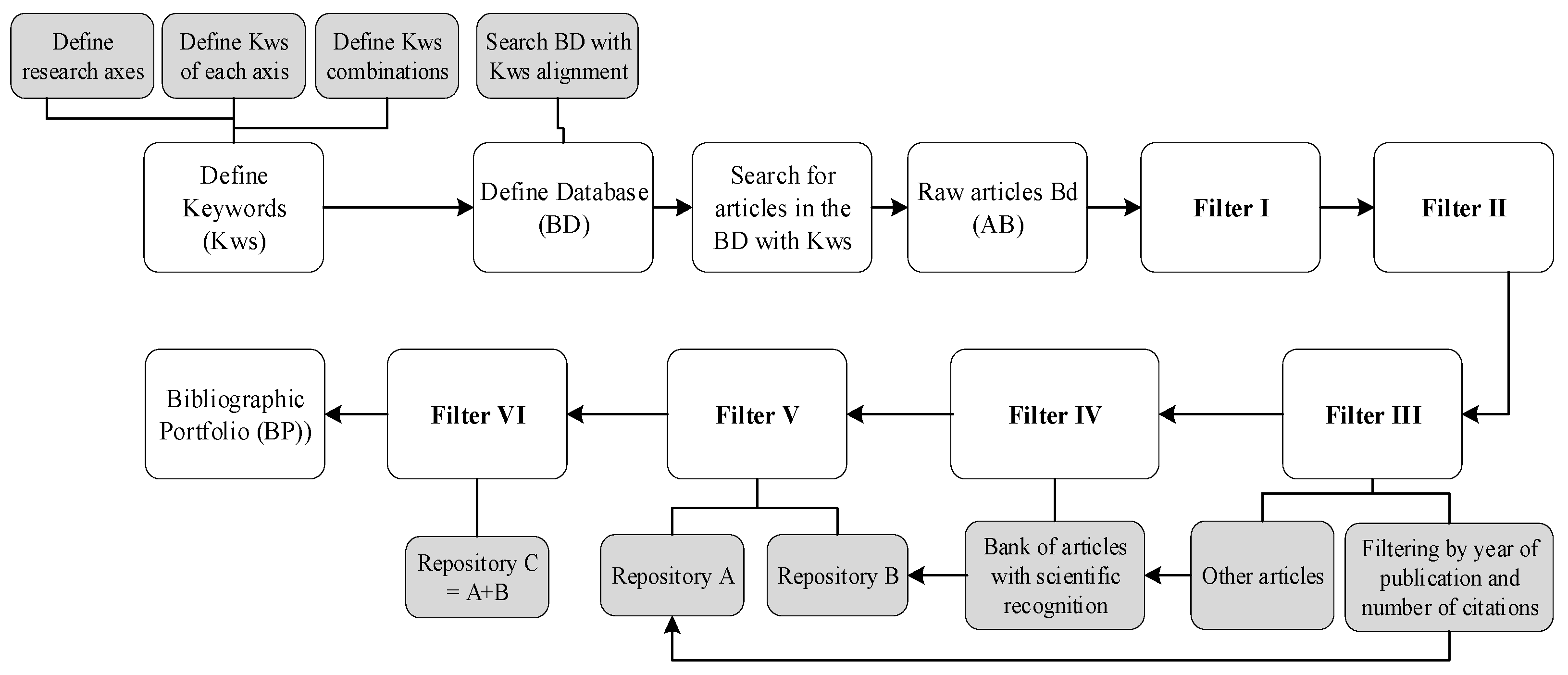
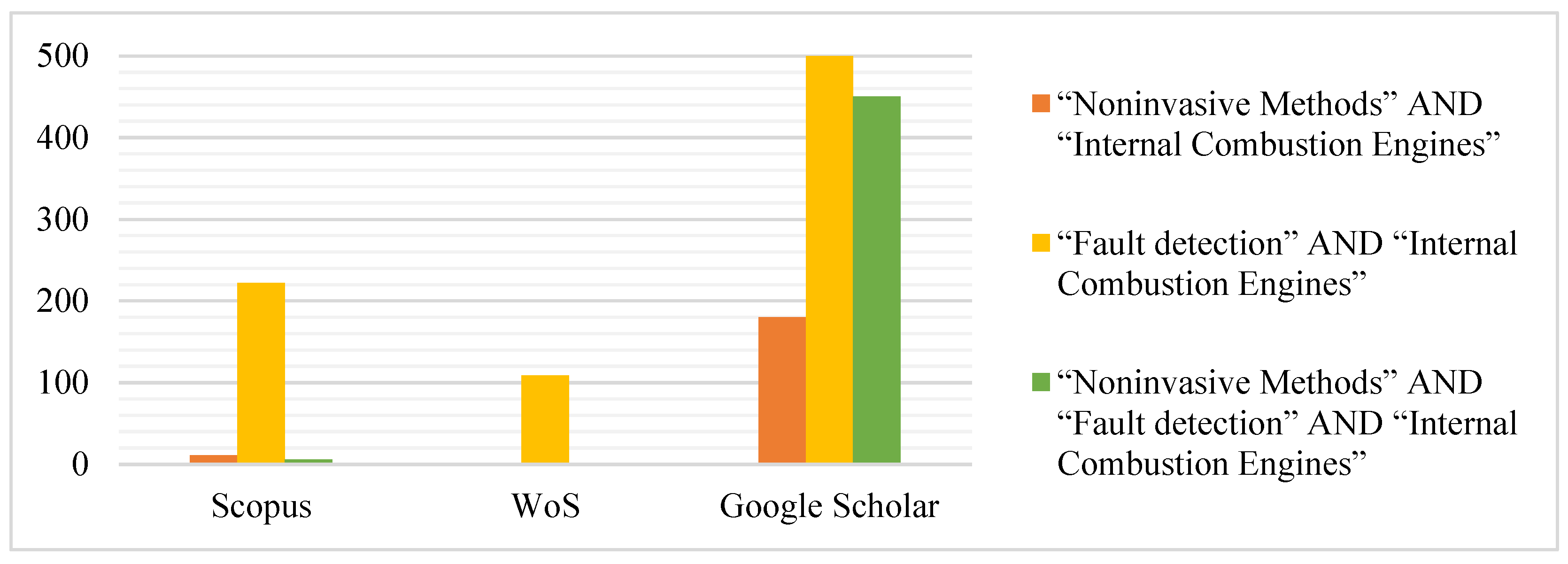
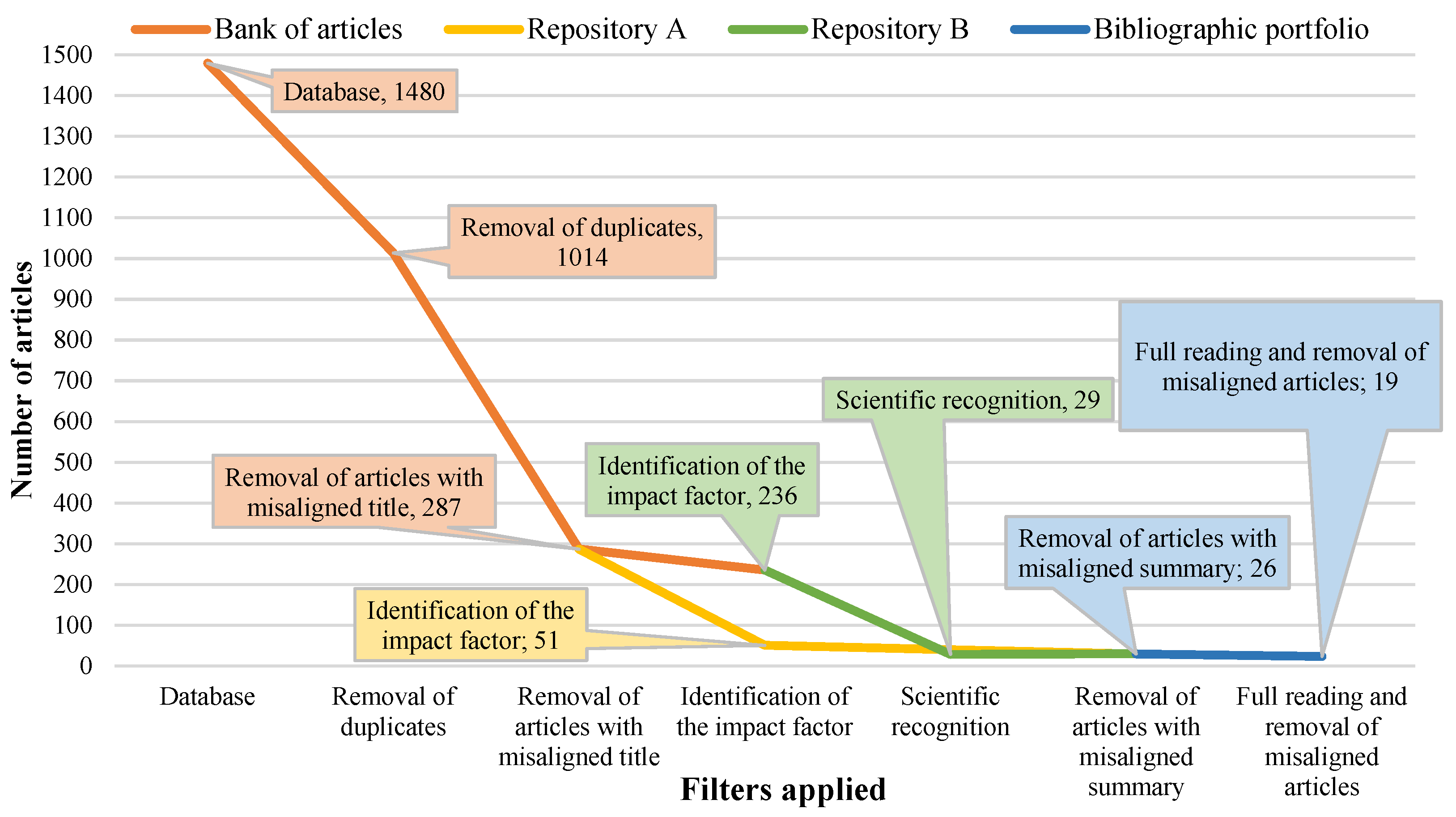
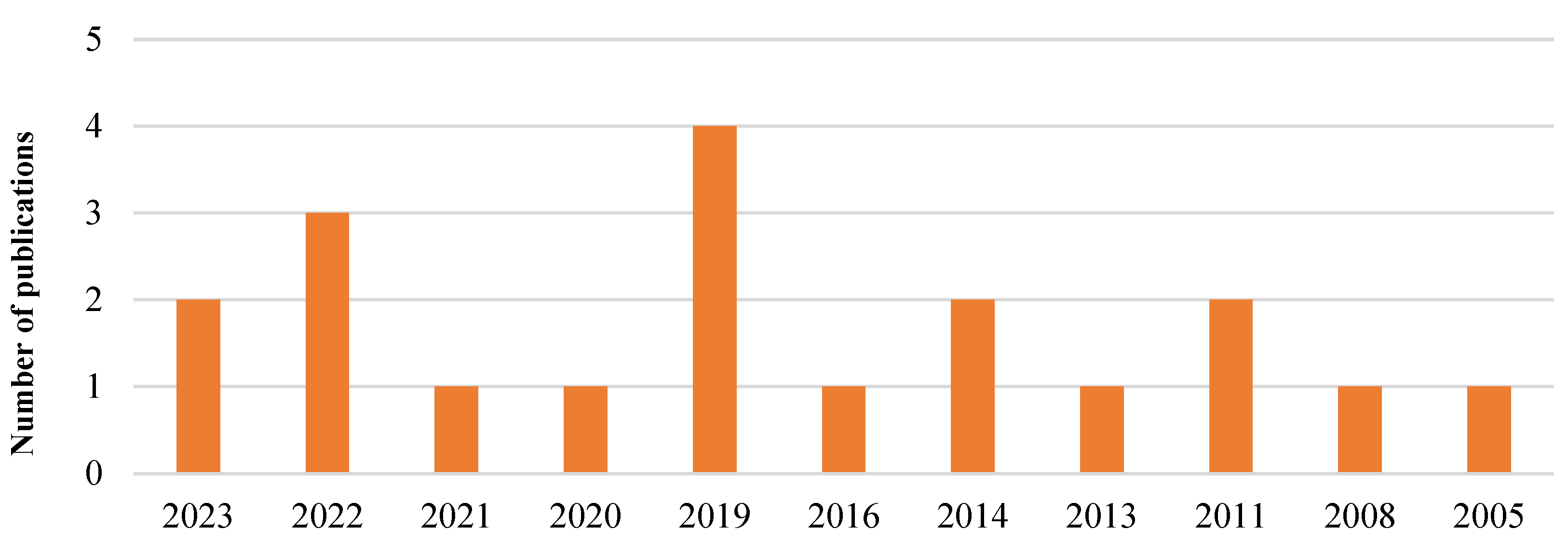

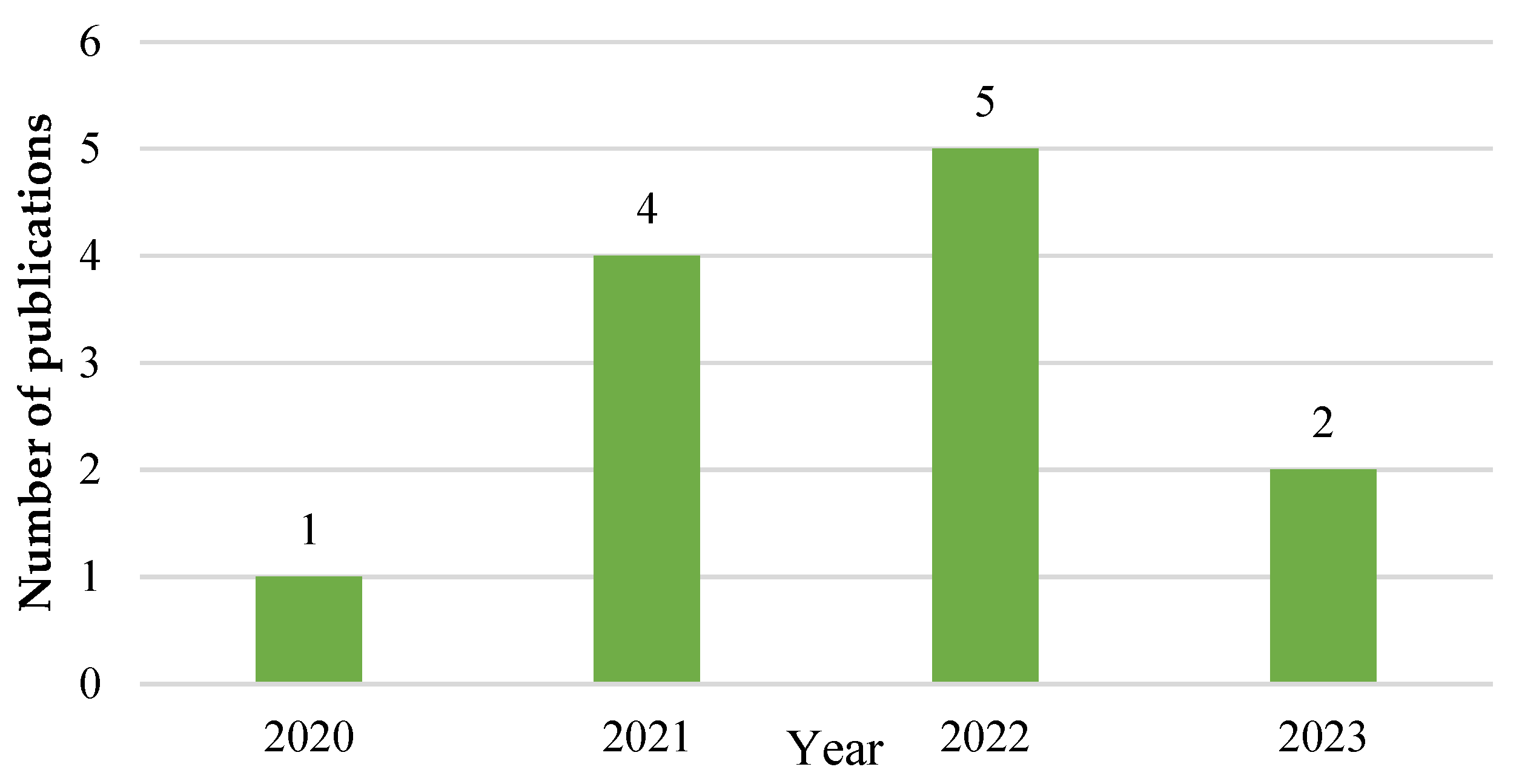
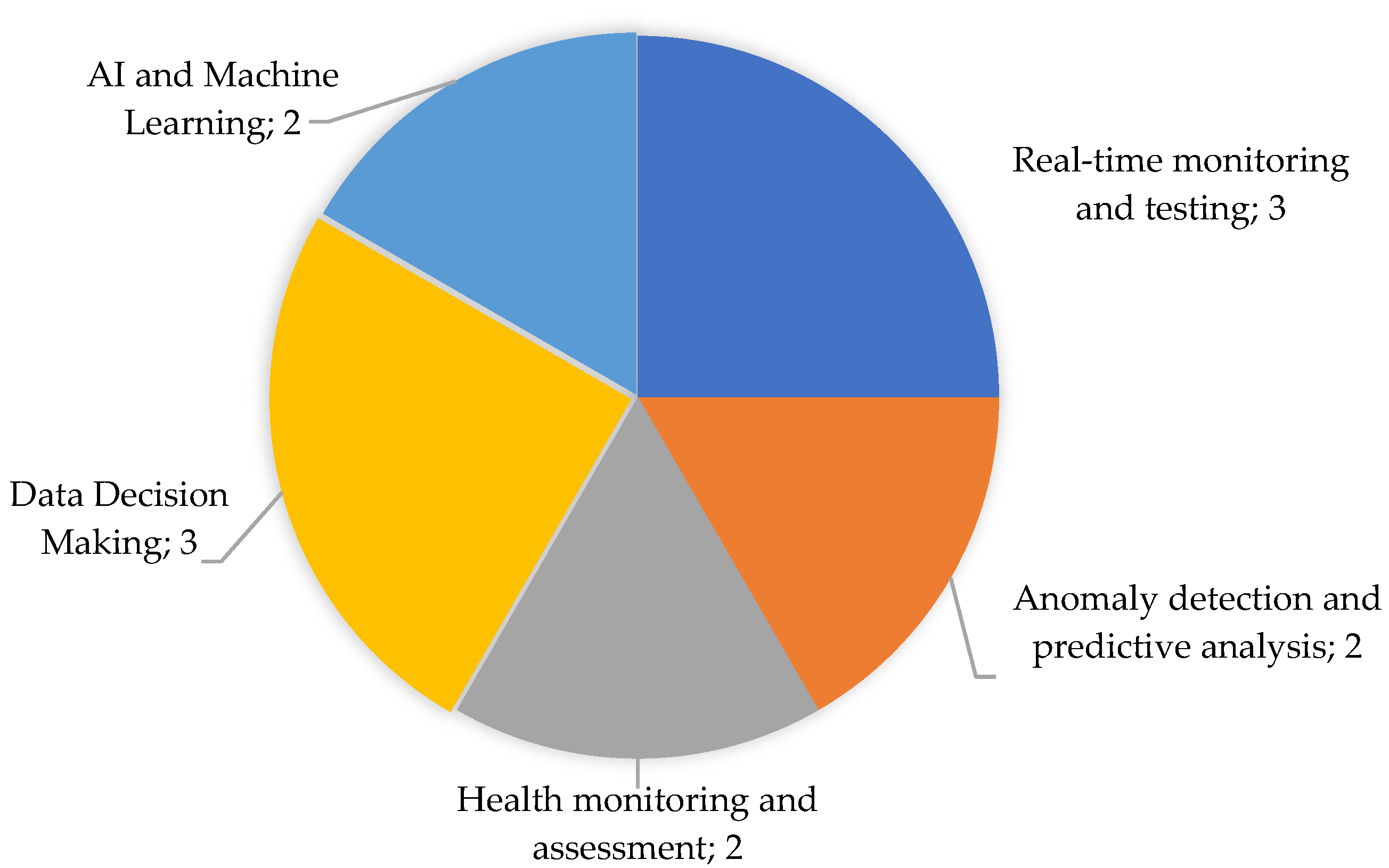
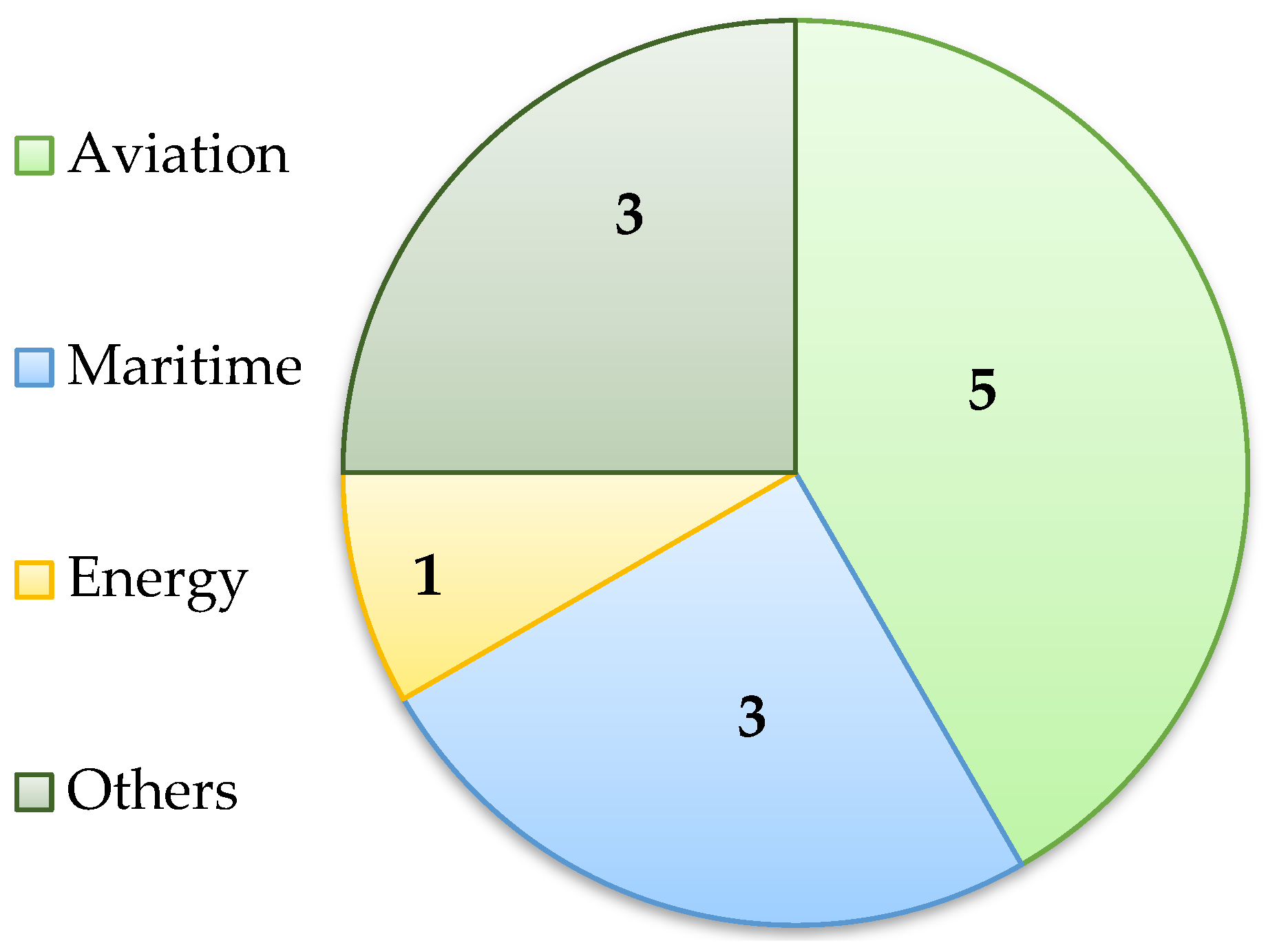
| Searched Combinations | SCOPUS | WoS | Google Scholar |
|---|---|---|---|
| “Noninvasive Methods” AND “Internal Combustion Engines” | 11 | 1 | 180 |
| “Fault detection” AND “Internal Combustion Engines” | 222 | 109 | 500 |
| “Noninvasive Methods” AND “Fault detection” AND “Internal Combustion Engines” | 6 | 1 | 450 |
| Total articles per database | 239 | 111 | 1130 |
| BP Articles | Ref. | Cit. |
|---|---|---|
| Diagnosis of internal combustion engine through vibration and acoustic pressure non-intrusive measurements | [41] | 135 |
| Application of the discrete wavelet transform and probabilistic neural networks in IC engine fault diagnostics | [33] | 81 |
| Application of vibration signal in the diagnosis of IC engine valve clearance | [42] | 76 |
| Performance Enhancement of Internal Combustion Engines through Vibration Control: State of the Art and Challenges | [43] | 37 |
| Acoustic Diagnostics Applications in the Study of Technical Condition of Combustion Engine | [26] | 30 |
| Fault Detection of a Flow Control Valve Using Vibration Analysis and Support Vector Machine | [35] | 28 |
| Misfire detection on internal combustion engines using exhaust gas temperature with low sampling rate | [44] | 26 |
| Ultrasonic Imaging of the Piston Ring Oil Film During Operation in a Motored Engine—Towards Oil Film Thickness Measurement | [45] | 25 |
| Fault diagnostics of the fuel injection system of a medium power maritime diesel engine with application of acoustic signal | [46] | 18 |
| Development of novel ultrasonic temperature measurement technology for combustion gas as a potential indicator of combustion instability diagnostics | [47] | 16 |
| Temperature measurements under diesel engine conditions using laser induced grating spectroscopy | [48] | 14 |
| Automated diagnostics of internal combustion engines using vibration simulation | [49] | 8 |
| Noninvasive Methods for Fault Detection and Isolation in Internal Combustion Engines Based on Chaos Analysis | [50] | 6 |
| Misfire Detection in Automotive Engines Using a Smartphone Through Wavelet and Chaos Analysis | [51] | 3 |
| Diagnosing Cracks in the Injector Nozzles of Marine Internal Combustion Engines during Operation Using Vibration Symptoms | [52] | 2 |
| Method of Fuel Injector Diagnosis Based on Analysis of Current Quantities | [53] | 2 |
| Ship Diesel Engine Fault Diagnosis Using Data Science and Machine Learning | [54] | 1 |
| Improving Misfire Fault Diagnosis with Cascading Architectures via Acoustic Vehicle Characterization | [55] | 1 |
| One Class Classification Based Anomaly Detection for Marine Engines | [56] | 1 |
| Searched Combinations | SCOPUS | WoS | Google Scholar |
|---|---|---|---|
| (“Digital Twin” OR “Digital-Twin” OR “Gêmeo Digital”) AND (“internal combustion engines” OR “internal combustion engine”) | 20 | 5 | 999 |
| (“Digital Twin” OR “Digital-Twin” OR “Gêmeo Digital”) AND (“internal combustion engines” OR “internal combustion engine”) AND (“Fault detection”) | 1 | 2 | 284 |
| Total articles per database | 21 | 7 | 1282 |
| BP Articles | Ref. | Cit. |
|---|---|---|
| A review of digital twin in product design and development | [57] | 229 |
| Digital twin applications in aviation industry: A review | [58] | 81 |
| A digital twin-based decision analysis framework for operation and maintenance of tunnels | [59] | 67 |
| Overcoming decision paralysis—A digital twin for decision making in energy system design | [60] | 55 |
| Digital twin-driven optimization of gas exchange system of 2-stroke heavy fuel aircraft engine | [14] | 46 |
| Towards marine dual fuel engines digital twins—integrated modelling of thermodynamic processes and control system functions | [12] | 42 |
| A twin data and knowledge-driven intelligent process planning framework of aviation parts | [61] | 34 |
| A framework of dynamic data driven digital twin for complex engineering products: the example of aircraft engine health management | [62] | 29 |
| A digital twin auxiliary approach based on adaptive sparse attention network for diesel engine fault diagnosis | [63] | 28 |
| A novel methodology for marine dual fuel engines sensors diagnostics and health management | [64] | 24 |
| Health assessment framework of marine engines enabled by digital twins | [65] | 7 |
| Hybrid turbo-shaft engine digital twining for autonomous air-crafts via AI and synthetic data generation. | [66] | 1 |
| BP Ref. | Method | Acquisition System | Processing System | Measurement Frequency | Diagnostic | ||||||||||||
|---|---|---|---|---|---|---|---|---|---|---|---|---|---|---|---|---|---|
| Invasive | Noninvasive | Sound | Vibration | Temperature | Current | Cylinder oil | DSP | IA | Sample | Continuous | Real time | Mechanical failures | Ignition failures | CO2 | Injection failures | Thickness of the oil film in the cylinder | |
| [41] | ✗ | ✓ | ✓ | ✓ | ✗ | ✗ | ✗ | ✓ | ✗ | ✓ | ✗ | ✗ | ✓ | ✗ | ✗ | ✗ | ✗ |
| [33] | ✗ | ✓ | ✓ | ✓ | ✗ | ✗ | ✗ | ✓ | ✗ | ✓ | ✗ | ✗ | ✓ | ✗ | ✗ | ✗ | ✗ |
| [42] | ✓ | ✗ | ✗ | ✓ | ✗ | ✗ | ✗ | ✗ | ✓ | ✓ | ✗ | ✗ | ✓ | ✗ | ✗ | ✗ | ✗ |
| [43] | ✗ | ✓ | ✗ | ✓ | ✗ | ✗ | ✗ | ✓ | ✗ | ✓ | ✗ | ✗ | ✓ | ✓ | ✗ | ✗ | ✗ |
| [26] | ✗ | ✓ | ✓ | ✗ | ✗ | ✗ | ✗ | ✓ | ✗ | ✓ | ✗ | ✗ | ✓ | ✗ | ✗ | ✗ | ✗ |
| [35] | ✗ | ✓ | ✗ | ✓ | ✗ | ✗ | ✗ | ✗ | ✓ | ✓ | ✗ | ✗ | ✓ | ✗ | ✗ | ✗ | ✗ |
| [44] | ✓ | ✗ | ✗ | ✗ | ✓ | ✗ | ✗ | ✓ | ✗ | ✗ | ✓ | ✗ | ✗ | ✓ | ✗ | ✗ | ✗ |
| [45] | ✗ | ✓ | ✗ | ✗ | ✗ | ✗ | ✓ | ✓ | ✗ | ✗ | ✓ | ✗ | ✗ | ✗ | ✗ | ✗ | ✓ |
| [46] | ✗ | ✓ | ✓ | ✗ | ✗ | ✗ | ✗ | ✓ | ✗ | ✓ | ✗ | ✗ | ✗ | ✗ | ✗ | ✓ | ✗ |
| [47] | ✗ | ✓ | ✗ | ✗ | ✓ | ✗ | ✗ | ✓ | ✗ | ✓ | ✗ | ✗ | ✗ | ✗ | ✗ | ✓ | ✗ |
| [48] | ✗ | ✓ | ✗ | ✗ | ✓ | ✗ | ✗ | ✓ | ✗ | ✓ | ✗ | ✗ | ✗ | ✓ | ✗ | ✗ | ✗ |
| [49] | ✗ | ✓ | ✗ | ✓ | ✗ | ✗ | ✗ | ✗ | ✓ | ✓ | ✗ | ✗ | ✓ | ✓ | ✗ | ✗ | ✗ |
| [50] | ✗ | ✓ | ✓ | ✗ | ✗ | ✗ | ✗ | ✓ | ✓ | ✗ | ✗ | ✓ | ✓ | ✗ | ✗ | ✗ | ✗ |
| [51] | ✗ | ✓ | ✗ | ✓ | ✗ | ✗ | ✗ | ✓ | ✗ | ✓ | ✗ | ✓ | ✗ | ✓ | ✗ | ✗ | ✗ |
| [52] | ✓ | ✗ | ✗ | ✓ | ✗ | ✗ | ✗ | ✓ | ✓ | ✓ | ✗ | ✓ | ✓ | ✗ | ✗ | ✗ | ✗ |
| [53] | ✗ | ✓ | ✗ | ✗ | ✗ | ✓ | ✗ | ✓ | ✗ | ✓ | ✗ | ✗ | ✗ | ✗ | ✗ | ✓ | ✗ |
| [54] | ✗ | ✓ | ✓ | ✓ | ✗ | ✗ | ✗ | ✗ | ✓ | ✓ | ✗ | ✗ | ✓ | ✗ | ✗ | ✗ | ✗ |
| [55] | ✗ | ✓ | ✓ | ✗ | ✗ | ✗ | ✗ | ✗ | ✓ | ✓ | ✗ | ✗ | ✗ | ✓ | ✗ | ✗ | ✗ |
| [56] | ✗ | ✓ | ✗ | ✓ | ✗ | ✗ | ✗ | ✓ | ✗ | ✓ | ✗ | ✗ | ✓ | ✓ | ✗ | ✗ | ✗ |
| [67] | ✗ | ✓ | ✗ | ✓ | ✗ | ✗ | ✗ | ✗ | ✓ | ✗ | ✗ | ✓ | ✓ | ✓ | ✗ | ✗ | ✗ |
| N° | Method Classification System that Used AI | Dataset | Acquisition System | Measurement Frequency | Diagnostic | ||||||||||||||
|---|---|---|---|---|---|---|---|---|---|---|---|---|---|---|---|---|---|---|---|
| BP Ref | Algorithm | Category | Sampling rate | Periodicity | Type Dataset | Public? | Sound | Vibration | Temperature | Current | Cylinder oil | Sample | Continuous | Real time | Mechanical failures | Ignition failures | CO2 | Injection failures | Thickness of the oil film in the cylinder |
| [33] | PNN | ANN | 200 samples | 50% training 50% test | Not specified | Not | ✓ | ✓ | ✗ | ✗ | ✗ | ✓ | ✗ | ✗ | ✓ | ✗ | ✗ | ✗ | ✗ |
| [42] | MLP | ANN | --- | --- | Experimental | Not | ✗ | ✓ | ✗ | ✗ | ✗ | ✓ | ✗ | ✗ | ✓ | ✗ | ✗ | ✗ | ✗ |
| [35] | SVM | Kernel method | 4000 samples | Not specified | Experimental | Not | ✗ | ✓ | ✗ | ✗ | ✗ | ✓ | ✗ | ✗ | ✓ | ✗ | ✗ | ✗ | ✗ |
| [49] | MLP e PNN | ANN | 593 samples 101 experimental 492 simulation | 100% trained by simulated data 100% trained by experimental data | Experimental and simulation models | Not | ✗ | ✓ | ✗ | ✗ | ✗ | ✓ | ✗ | ✗ | ✓ | ✓ | ✗ | ✗ | ✗ |
| [50] | ANN | ANN | 1440 samples | 60% training 40% test | Experimental | Not | ✓ | ✗ | ✗ | ✗ | ✗ | ✗ | ✗ | ✓ | ✓ | ✗ | ✗ | ✗ | ✗ |
| [52] | ANN | ANN | --- | --- | Not specified | Not | ✗ | ✓ | ✗ | ✗ | ✗ | ✓ | ✗ | ✓ | ✓ | ✗ | ✗ | ✗ | ✗ |
| [54] | SVM | Kernel method | 16,384 samples | 80% training 20% test | Experimental | Not | ✓ | ✓ | ✗ | ✗ | ✗ | ✓ | ✗ | ✗ | ✓ | ✗ | ✗ | ✗ | ✗ |
| [55] | CNN | ANN | 286 samples | 80% training 20% test | Experimental | Not | ✓ | ✗ | ✗ | ✗ | ✗ | ✓ | ✗ | ✗ | ✗ | ✓ | ✗ | ✗ | ✗ |
| [56] | OCSVM | ANN | 4.8 kHz | Not specified | Experimental | Not | ✗ | ✓ | ✗ | ✗ | ✗ | ✓ | ✗ | ✗ | ✓ | ✓ | ✗ | ✗ | ✗ |
| [67] | MFRCNN | ANN | 51.2 kHz | Not specified | Experimental | Not | ✗ | ✓ | ✗ | ✗ | ✗ | ✗ | ✗ | ✓ | ✓ | ✓ | ✗ | ✗ | ✗ |
Disclaimer/Publisher’s Note: The statements, opinions and data contained in all publications are solely those of the individual author(s) and contributor(s) and not of MDPI and/or the editor(s). MDPI and/or the editor(s) disclaim responsibility for any injury to people or property resulting from any ideas, methods, instructions or products referred to in the content. |
© 2024 by the authors. Licensee MDPI, Basel, Switzerland. This article is an open access article distributed under the terms and conditions of the Creative Commons Attribution (CC BY) license (https://creativecommons.org/licenses/by/4.0/).
Share and Cite
Torres, N.N.S.; Lima, J.G.; Maciel, J.N.; Gazziro, M.; Filho, A.C.L.; Souto, C.R.; Salvadori, F.; Ando Junior, O.H. Non-Invasive Techniques for Monitoring and Fault Detection in Internal Combustion Engines: A Systematic Review. Energies 2024, 17, 6164. https://doi.org/10.3390/en17236164
Torres NNS, Lima JG, Maciel JN, Gazziro M, Filho ACL, Souto CR, Salvadori F, Ando Junior OH. Non-Invasive Techniques for Monitoring and Fault Detection in Internal Combustion Engines: A Systematic Review. Energies. 2024; 17(23):6164. https://doi.org/10.3390/en17236164
Chicago/Turabian StyleTorres, Norah Nadia Sánchez, Jorge Gomes Lima, Joylan Nunes Maciel, Mario Gazziro, Abel Cavalcante Lima Filho, Cicero Rocha Souto, Fabiano Salvadori, and Oswaldo Hideo Ando Junior. 2024. "Non-Invasive Techniques for Monitoring and Fault Detection in Internal Combustion Engines: A Systematic Review" Energies 17, no. 23: 6164. https://doi.org/10.3390/en17236164
APA StyleTorres, N. N. S., Lima, J. G., Maciel, J. N., Gazziro, M., Filho, A. C. L., Souto, C. R., Salvadori, F., & Ando Junior, O. H. (2024). Non-Invasive Techniques for Monitoring and Fault Detection in Internal Combustion Engines: A Systematic Review. Energies, 17(23), 6164. https://doi.org/10.3390/en17236164








